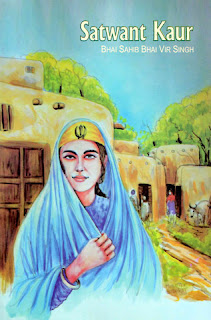I have been into
knowing Sikhism for quite a while now and the more I go deeper I am amazed by
the sense of determination and courage with which Sikh Gurus protected the sanctity of their religion. Most recently I have known about Sri
Guru Harkrishan Ji, The youngest of all Gurus who took Guru Ship on 23 July
1656. He was just five but had the ability to lead the Sikh sangat and take it
further.
“The
Sikhs recognized him as the picture of Guru Nanak. They saw on Guru Har
Krishan's handsome face the same light as must have been on Guru Nanak's. Guru
Har Krishan had a rare ability in explaining passages from the HolyGranth. He
delighted the hearts of his disciples by his commentaries. He reminded them to
cherish the One God alone, and asked them to discard passions and learn the
virtues of patience, charity and love. Thus Guru Har Krishan carried on the
teaching of the Gurus and preserved intact the legacy he had inherited from
them.”
But Guru
Harkrishan Ji led a very short span of his life with which he could take
forward the religious tenets of Sikhism as taught by first Guru, Sri Guru Nanak
Dev Ji. Guru Harkrishan ji left us on 30 March 1664. During his Guruship when
Guru Sahib Ji was at Kiratpur, the then emperor of Delhi, Aurangzeb, sent up
his message that he wanted Guru Ji to visit Delhi and also meet him in his
court. Although Guruji accepted his invitation on the advice of Baba Gurditta
Ji, Bhai Dargah Mal Ji and Bhai Mani Singh Ji but never went to Aurangzeb’s
court to meet him. Such was his conviction to pay respect to his father Guru
Har Rai Ji of not meeting the emperor under any circumstances.
Guru Harkrishan
Ji’s elder brother Ram Rai was disowned by his father, Guru Har Rai Ji for
showing miracles in Aurangzeb’s court and therefore Guru Har Rai Ji advised his
younger son Guru Harkrishan sahib of not meeting the emperor ever in his life. On
reaching Delhi, Aurangzeb wished to see the Guru but Guru Harkrishan Ji had
already announced his decision of not meeting Aurangzeb under any situation,
and the Guru was ready to face any consequence for his refusal to meet
Aurangzeb. This further infuriated the arrogant ruler, Aurangzeb.
When Guru Harkrishan Ji was in Delhi, the city was plagued by the gruesome epidemic of small pox and every other house got affected by it. As the disease was contagious, people started falling sick and the disease was spreading like wild fire. Guru Harkrishan Ji possessed divine powers which he used only to help the needy in trouble. Guruji decided to take the disease on him. This was the only possible solution to save people of Delhi and also foiled Aurangzeb’s plan of meeting the Guru. Guruji’s conviction to save mankind and his decision of meeting the Guru shows his sense of determination and respect for his father and also his responsibility to safeguard his religion. We salute you Guruji was the priceless gift of life you gave to all those suffering from smallpox.
Guruji’s mother Mata
Sulakkhani, was very sad and unable to see his son in such a state, she said, "Son,
you occupy the gaddi of Guru Nanak. You are the healer of the world's sorrows
and sufferings. Your very sight removes the ailments of others. Why do you lie
sick now?" Guru Har Krishan Ji replied, "He who has taken this mortal frame must go through sickness and
disease. Both happiness and suffering are part of life. What is ordained must
happen. This is what Guru Nanak taught. Whatever He does is His order. One must
walk in the light of His command."
These were his
last words- “None in this world live
forever. The body is mortal. In the Granth abides the Guru' s spirit. Daily bow
your head to it. So will you conquer your passions and attain liberation."
Guru Ji endured all the pain of the disease and left us all on 30th
March 1664. Guru Ji taught us the meaning of utmost determination and
conviction towards what is true and right and never accept any kind of
oppression. We bow to our Guru and pray for the well being of all.
To know more about Guru Harkrishan Ji and his teachings
please visit http://www.sikhbookclub.com/books/guru-har-krishan-ji-books-english/1656/2896










